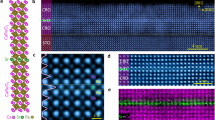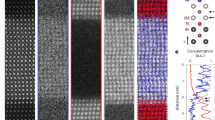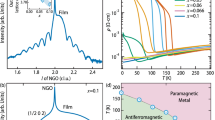Abstract
To fully deploy the potential of semiconductor nanocrystal films as low-cost electronic materials, a better understanding of the amount of dopants required to make their conductivity metallic is needed. In bulk semiconductors, the critical concentration of electrons at the metal–insulator transition is described by the Mott criterion. Here, we theoretically derive the critical concentration nc for films of heavily doped nanocrystals devoid of ligands at their surface and in direct contact with each other. In the accompanying experiments, we investigate the conduction mechanism in films of phosphorus-doped, ligand-free silicon nanocrystals. At the largest electron concentration achieved in our samples, which is half the predicted nc, we find that the localization length of hopping electrons is close to three times the nanocrystals diameter, indicating that the film approaches the metal–insulator transition.
This is a preview of subscription content, access via your institution
Access options
Subscribe to this journal
Receive 12 print issues and online access
$259.00 per year
only $21.58 per issue
Buy this article
- Purchase on Springer Link
- Instant access to full article PDF
Prices may be subject to local taxes which are calculated during checkout



Similar content being viewed by others
References
Gur, I., Fromer, N. A., Geier, M. L. & Alivisatos, A. P. Air-stable all-inorganic nanocrystal solar cells processed from solution. Science 310, 462–465 (2005).
Wood, V. & Bulovic, V. Colloidal quantum dot light-emitting devices. Nano Rev. 1, 1–7 (2010).
Turk, M. E. et al. Gate-induced carrier delocalization in quantum dot field effect transistors. Nano Lett. 14, 5948–5952 (2014).
Gresback, R. et al. Controlled doping of silicon nanocrystals investigated by solution-processed field effect transistors. ACS Nano 8, 5650–5656 (2014).
Alivisatos, A. P. Semiconductor clusters, nanocrystals, and quantum dots. Science 271, 933–937 (1996).
Sargent, E. H. Infrared photovoltaics made by solution processing. Nature Photon. 3, 325–331 (2009).
Murray, C. B., Norris, D. J. & Bawendi, M. G. Synthesis and characterization of nearly monodisperse CdE (E = sulfur, selenium, tellurium) semiconductor nanocrystallites. J. Am. Chem. Soc. 115, 8706–8715 (1993).
Talapin, D. V. & Murray, C. B. PbSe nanocrystal solids for n- and p-channel thin film field-effect transistors. Science 310, 86–89 (2005).
Yu, D., Wang, C. & Guyot-Sionnest, P. n-type conducting CdSe nanocrystal solids. Science 300, 1277–1280 (2003).
Wang, C., Shim, M. & Guyot-Sionnest, P. Electrochromic nanocrystal quantum dots. Science 291, 2390–2392 (2001).
Oh, S. J. et al. Stoichiometric control of lead chalcogenide nanocrystal solids to enhance their electronic and optoelectronic device performance. ACS Nano 7, 2413–2421 (2013).
Norris, D. J., Efros, A. L. & Erwin, S. C. Doped nanocrystals. Science 319, 1776–1779 (2008).
Mocatta, D. et al. Heavily doped semiconductor nanocrystal quantum dots. Science 332, 77–81 (2011).
Sahu, A. et al. Electronic impurity doping in CdSe nanocrystals. Nano Lett. 12, 2587–2594 (2012).
Guyot-Sionnest, P. Electrical transport in colloidal quantum dot films. J. Phys. Chem. Lett. 3, 1169–1175 (2012).
Shabaev, A., Efros, A. L. & Efros, A. L. Dark and photo-conductivity in ordered array of nanocrystals. Nano Lett. 13, 5454–5461 (2013).
Scheele, M. To be or not to be: Band-like transport in quantum dot solids. Z. Phys. Chem. 229, 167–178 (2015).
Mott, N. F. Metal–insulator transition. Rev. Mod. Phys. 40, 677–683 (1968).
Sharvin, Y. V. A possible method for studying Fermi surfaces. Sov. J. Exp. Theor. Phys. 21, 655–656 (1965).
Nikolić, B. & Allen, P. B. Electron transport through a circular constriction. Phys. Rev. B 60, 3963–3969 (1999).
Nazarov, Y. & Blanter, Y. Quantum Transport: Introduction to Nanoscience (Cambridge Univ. Press, 2009).
Matveev, K. A. Coulomb blockade at almost perfect transmission. Phys. Rev. B 51, 1743–1751 (1995).
Beloborodov, I. S., Lopatin, A. V., Vinokur, V. M. & Efetov, K. B. Granular electronic systems. Rev. Mod. Phys. 79, 469–518 (2007).
Liljeroth, P. et al. Variable orbital coupling in a two-dimensional quantum-dot solid probed on a local scale. Phys. Rev. Lett. 97, 096803 (2006).
Lee, J.-S., Kovalenko, M. V., Huang, J., Chung, D. S. & Talapin, D. V. Band-like transport, high electron mobility and high photoconductivity in all-inorganic nanocrystal arrays. Nature Nanotech. 6, 348–352 (2011).
Choi, J.-H. et al. Bandlike transport in strongly coupled and doped quantum dot solids: A route to high-performance thin-film electronics. Nano Lett. 12, 2631–2638 (2012).
Liu, W., Lee, J.-S. & Talapin, D. V. III–V nanocrystals capped with molecular metal chalcogenide ligands: High electron mobility and ambipolar photoresponse. J. Am. Chem. Soc. 135, 1349–1357 (2013).
Skinner, B., Chen, T. & Shklovskii, B. I. Theory of hopping conduction in arrays of doped semiconductor nanocrystals. Phys. Rev. B 85, 205316 (2012).
Mangolini, L., Thimsen, E. & Kortshagen, U. High-yield plasma synthesis of luminescent silicon nanocrystals. Nano Lett. 5, 655–659 (2005).
Rowe, D. J., Jeong, J. S., Mkhoyan, K. A. & Kortshagen, U. R. Phosphorus-doped silicon nanocrystals exhibiting mid-infrared localized surface plasmon resonance. Nano Lett. 13, 1317–1322 (2013).
Zabrodskii, A. G. The Coulomb gap: The view of an experimenter. Philos. Mag. B 81, 1131–1151 (2001).
Maxwell, J. C. A Treatise on Electricity and Magnetism Vol. 1 (Clarendon Press, 1881).
Marra, D. C., Edelberg, E. A., Naone, R. L. & Aydil, E. S. Silicon hydride composition of plasma-deposited hydrogenated amorphous and nanocrystalline silicon films and surfaces. J. Vac. Sci. Technol. A 16, 3199–3210 (1998).
Miura, T., Niwano, M., Shoji, D. & Miyamoto, N. Kinetics of oxidation on hydrogenterminated si(100) and (111) surfaces stored in air. J. Appl. Phys. 79, 4373–4380 (1996).
Acknowledgements
The authors would like to thank K. A. Matveev, C. Leighton, B. Skinner and A. Kamenev for helpful discussions, C. D. Frisbie for the use of his equipment and R. Knurr for assistance with the ICP-OES analysis. T.C. (electrical transport studies) and K.V.R.(theory) were supported primarily by the National Science Foundation through the University of Minnesota MRSEC under Award Number DMR-1420013. N.J.K. (materials synthesis) was supported by the DOE Center for Advanced Solar Photophysics (CASP), an Energy Frontier Research Center funded by the U.S. Department of Energy, Office of Science, Basic Energy Sciences. Part of this work was carried out in the College of Science and Engineering Characterization Facility, University of Minnesota, which has received capital equipment funding from the NSF through the UMN MRSEC Program. Part of this work also used the College of Science and Engineering Nanofabrication Center, University of Minnesota, which receives partial support from NSF through the NNIN Program.
Author information
Authors and Affiliations
Contributions
K.V.R., H.F. and B.I.S. created the theory. T.C. performed the structural and electrical characterization. N.J.K. synthesized materials. U.R.K. discussed and supervised the work. All authors participated in the discussion and interpretation of the results and co-wrote the manuscript.
Corresponding author
Ethics declarations
Competing interests
The authors declare no competing financial interests.
Supplementary information
Supplementary Information
Supplementary Information (PDF 597 kb)
Rights and permissions
About this article
Cite this article
Chen, T., Reich, K., Kramer, N. et al. Metal–insulator transition in films of doped semiconductor nanocrystals. Nature Mater 15, 299–303 (2016). https://doi.org/10.1038/nmat4486
Received:
Accepted:
Published:
Issue Date:
DOI: https://doi.org/10.1038/nmat4486
This article is cited by
-
Enabling metallic behaviour in two-dimensional superlattice of semiconductor colloidal quantum dots
Nature Communications (2023)
-
Quantum transports in two-dimensions with long range hopping
Scientific Reports (2023)
-
Superior carrier tuning in ultrathin superconducting materials by electric-field gating
Nature Reviews Physics (2022)
-
Novel rare-earth Eu and La co-doped ZnO nanoparticles synthesized via co-precipitation method: optical, electrical, and magnetic properties
Journal of Materials Science: Materials in Electronics (2022)
-
Hierarchical carrier transport simulator for defected nanoparticle solids
Scientific Reports (2021)



